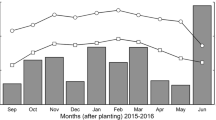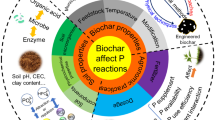Abstract
The use of biochar in agriculture to achieve the dual benefits of improving soil quality whilst sequestering carbon (C) has received much attention. However, in low-intensity broadacre agricultural systems where yield is constrained by rainfall and costs associated with phosphorus (P) fertiliser, the application of biochar at rates commonly reported (>10 t ha−1) are likely to be prohibitively expensive where yield benefits cannot be guaranteed. In marginal areas where calcareous soils dominate, biochar application has no liming effect, reducing its value compared to application in acidic soils. In the present study, we use a field experiment to investigate the interaction between P fertilisation and biochar banding at low application rates (<1 t ha−1) on wheat yield and soil P fractionation (assessed by a modified Hedley method) in a highly alkaline Haplic Calcisol in a dryland broadacre cropping system. Our results demonstrate no statistically significant effect of low rate biochar banding on wheat yield in this highly P-constrained soil, but a significant effect of both biochar and fertiliser on P fractionation in both years of the study. Higher P fertiliser rates significantly increased wheat yield in all biochar treatments. The interactions between biochar, P fertiliser and P fractionation indicate shifts in potential P availability both as a result of P fertilisation and also biochar application. Further work is required in low productivity calcareous systems such as that studied here to elucidate the potential for biochar amendment to improve productivity and sequester C.






Similar content being viewed by others
References
Ahlgren J, Djodjic F, Börhessen G, Mattson L (2013) Identification and quantification of organic phosphorus forms in soils from fertility experiments. Soil Use Manage 29(Suppl 1):24–35
Anderson CR, Condron LM, Clough TJ, Fiers M, Steward A, Hill RA, Sherlock RR (2011) Biochar induced soil microbial community change: implications for biogeochemical cycling of carbon, nitrogen and phosphorus. Pedobiologia 54:309–320
Atkinson CJ, Fitzgerald JD, Hipps NA (2010) Potential mechanisms for achieving agricultural benefits from biochar application to temperate soil: a review. Plant Soil 337:1–18
Bertrand I, Holloway RE, Armstrong RD, McLaughlin MJ (2003) Chemical characteristics of phosphorus in alkaline soils in southern Australia. Aust J Soil Res 41:61–76
Blackwell P, Krull E, Butler G, Herbert A, Solaiman Z (2010) Effect of banded biochar on dryland wheat production and fertiliser use in south-western Australia: an agronomic and economic perspective. Aust J Soil Res 48:531–545
Chan KY, Van Zwieten L, Meszaros I, Downie A, Joseph S (2007) Agronomic values of greenwaste biochar as a soil amendment. Aust J Soil Res 45:629–634
Condron LM, Newman S (2011) Revisiting the fundamentals of phosphorus fractionation of sediments and soils. J Soils Sediments 11:830–840
Condron LM, Turner BL, Cade-Menun BJ (2005) Chemistry and dynamics of soil organic phosphorus. In: Sims JT, Sharpley AN (eds) Phosphorus: agriculture and the environment. Soil Science Society of America, Madison, pp 87–121
Cordell D, Dranget J-O, White S (2009) The story of phosphorus: global food security and food for thought. Global Environ Change 19:292–305
Cui HJ, Wang MK, Fu ML, Ci E (2011) Enhancing phosphorus availability in phosphorus-fertilized zones by reducing phosphate adsorbed to ferrihydrite using rice straw-derived biochar. J Soil Sediment 11:1135–1141
DeLuca TH, MacKenzie MD, Gundale MJ (2009) Biochar effects on soil nutrient transformations. In: Lehmann J, Joseph S (eds) Biochar for environmental management: science and technology. Earthscan, London, pp 251–270
den Elzen MGJ, Hof AF, Mendoza Beltran A, Grassi G, Roelfsema M, van Ruijven B, van Vilet J, van Vuuren DP (2011) The Copenhagen Accord: abatement costs and carbon prices resulting from the submissions. Environ Sci Policy 14:28–39
Ebina J, Tsutsui T, Shirai T (1983) Simultaneous determination of total nitrogen and total phosphorus in water using peroxodisulfate oxidation. Water Res 17:1721–1726
Edelstein DM, Tonjes DJ (2012) Modeling an improvement in phosphorus utilisation in tropical agriculture. J Sustain Agr 36:18–35
Farrell M, Healey JR, Godbold DL, Nason MA, Tandy S, Jones DL (2011) Modification of fertility of soil materials for restoration of acidic grassland habitat. Restor Ecol 19:509–519
Farrell M, Kuhn TK, Macdonald LM, Maddern TM, Murphy DV, Hall PA, Singh BP, Baumann K, Krull ES, Baldock JA (2013b) Microbial utilisation of biochar-derived carbon. Sci Total Environ. doi:10.1016/j.scitotenv.2013.03.090
Farrell M, Rangott G, Krull E (2013b) Difficulties in using soil-based methods to assess plant availability of potentially toxic elements in biochars and their feedstocks. J Hazard Mater 250–251:29–36
Fernández-Pérez M, Flores-Céspedes F, González-Pradas E, Ureña-Amate MD, Villafranca-Sánchez M, Socías-Viciana M, Pérez-García S (2005) Effects of dissolved organic carbon on phosphate retention on two calcareous soils. J Agric Food Chem 53:84–89
Hedley MJ, White RE, Nye PH (1982) Plant-induced changes in the rhizosphere of rape (Brassica napus var. Emerald) seedlings III. Changes in L value, soil phosphate fractions and phosphatise activity. New Phytol 91:45–56
Jalali M, Tabar SS (2011) Chemical fractionation of phosphorus in calcareous soils of Hamedan, western Iran under different land use. J Plant Nutr Soil Sci 174:523–531
Jeffery S, Verheijen FGA, van der Velde M, Bastos AC (2011) A quantitative review of the effects of biochar applications to soils on crop productivity using meta-analysis. Agr Ecosyst Environ 144:175–187
Jeffrey SJ, Carter JO, Moodie KM, Beswick AR (2001) Using spatial interpolation to construct a comprehensive archive of Australian climate data. Environ Modell Softw 16:309–330
Jones DL, Rousk J, Edwards-Jones G, DeLuca TH, Murphy DV (2012) Biochar-mediated changes in soil quality and plant growth in a three year field trial. Soil Biol Biochem 45:113–124
Keating BA, Carberry PS (2010) Emerging opportunities and challenges for Australian broadacre agriculture. Crop Pasture Sci 61:269–278
Khademi Z, Jones DL, Malakouti MJ, Asadi F (2010) Organic acids differ in enhancing phosphorus uptake by Triticum aestivum L.—effects of rhizosphere concentration and counterion. Plant Soil 334:151–159
Lehmann J, Rillig MC, Thies J, Masiello CA, Hockaday WC, Crowley D (2011) Biochar effects on soil biota—a review. Soil Biol Biochem 43:1812–1836
Lentz RD, Ippolito JA (2012) Biochar and manure affect calcareous soil and corn silage nutrient concentrations and uptake. J Environ Qual 41:1033–1042
McBeath T, Armstrong RD, Lombi E, McLaughlin MJ, Holloway RE (2005) Responsiveness of wheat (Triticum aestivum) to liquid and granular phosphorus fertilisers in southern Australian soils. Aust J Soil Res 43:203–212
McLaughlin MJ, MacBeath TM, Smernik R, Stacey SP, Ajiboye B, Guppy C (2011) The chemical nature of P accumulation in agricultural soil—implications for fertiliser management and design: an Australian perspective. Plant Soil 349:69–87
Mukherjee A, Zimmerman AR (2013) Organic carbon and nutrient release from a range of laboratory-produced biochars and biochar-soil mixtures. Geoderma 193–194:122–130
Ohno T, Zibilski LM (1991) Determination of low concentrations of phosphorus in soil extracts using malachite green. Soil Sci Soc Am J 55:892–895
Parvage MM, Ulén B, Eriksson J, Strock J, Kirchmann H (2013) Phosphorus availability in soils amended with wheat residue char. Biol Fertil Soils 49:245–250
Pratt K, Moran D (2010) Evaluating cost-effectiveness of global biochar mitigation potential. Biomass Bioenergy 34:1149–1158
Prendergast-Miller MT, Duvall M, Sohi SP (2013) Biochar–root interactions are mediated by nutrient content and biochar impacts on soil nutrient availability. Eur J Soil Sci (in press)
Roberts KG, Gloy BA, Joseph S, Scott NR, Lehmann J (2010) Life cycle assessment of biochar systems: estimating the energetic, economic and climate change potential. Environ Sci Technol 44:827–833
Sadras VO, Angus JF (2006) Benchmarking water-use efficiency of rainfed wheat in dry environments. Aust J Agr Res 57:847–856
Schmidt A, Smernik RJ, McBeath TM (2012) Measuring organic carbon in Calcarosols: understanding the pitfalls and complications. Soil Res 50:397–405
Shariatmadari H, Shirvani M, Dehghan RA (2007) Availability of organic and inorganic phosphorus fractions to wheat in toposequences of calcareous soils. Commun Soil Sci Plant 38:2601–2617
Simpson M, McLenaghen RD, Chirino-Valle I, Condron LM (2012) Effects of long-term grassland management on the chemical nature and bioavailability of soil phosphorus. Bio Fertil Soils 48:607–611
Sohi SP, Krull E, Lopez-Capel E, Bol R (2010) A review of biochar and its use and function in soil. Adv Agron 105:47–82
Solaiman ZM, Blackwell P, Abbott LK, Storer P (2010) Direct and residual effect of biochar application on mycorrhizal root colonisation, growth and nutrition of wheat. Aust J Soil Res 48:546–554
Townend J (2002) Practical statistics for environmental and biological scientists. Wiley, Chichester
Van Zwieten L, Kimber S, Morris S, Chan KY, Downie A, Rust S, Joseph S, Cowie A (2010) Effects of biochar from slow pyrolysis papermill waste on agronomic performance and soil fertility. Plant Soil 327:235–246
Voroney RP, Brookes PC, Beyaert RP (2008) Soil microbial biomass C, N, P, and S. In: Carter MR, Gregorich EG (eds) Soil sampling and methods of analysis, 2nd edn. CRC, Boca Raton, pp 637–651
Woolf D, Amonette JE, Street-Perrott FA, Lehmann J (2010) Sustainable biochar to mitigate global climate change. Nat Commun 1:56
Warnock DD, Lehmann J, Kuyper TW, Rillig MC (2007) Mycorrhizal responses to biochar in soil—concepts and mechanisms. Plant Soil 300:9–20
Yang JE, Jacobsen JS (1990) Soil inorganic phosphorus fractions and their uptake relations in calcareous soils. Soil Sci Soc Am J 54:1666–1669
Acknowledgments
This project is supported by funding from the Australian Government under its Climate Change Research Program and through the CSIRO Sustainable Agriculture Flagship. Mr Thomas Carter and Mrs Janine McGowan of CSIRO are thanked for technical support. Mr Simon Patterson is thanked for providing the land on which the trial was conducted. Dr Evelyn Krull is acknowledged for her early comments and guidance in experimental design.
Author information
Authors and Affiliations
Corresponding author
Rights and permissions
About this article
Cite this article
Farrell, M., Macdonald, L.M., Butler, G. et al. Biochar and fertiliser applications influence phosphorus fractionation and wheat yield. Biol Fertil Soils 50, 169–178 (2014). https://doi.org/10.1007/s00374-013-0845-z
Received:
Revised:
Accepted:
Published:
Issue Date:
DOI: https://doi.org/10.1007/s00374-013-0845-z




